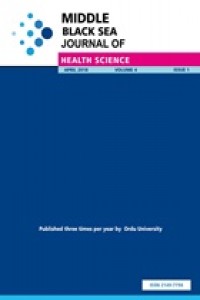Öz
Kaynakça
- Seyhan Ünlü seyhanunlu@yahoo.com
- Önder Ersan onersan@gmail.com
Öz
Objective: Distal
radius fractures are common fractures in the adult population. For treatment,
intramedullary nailing has the advantage of providing effective internal
fixation with minimum soft tissue damage. We aimed to present our experience
with the use of intramedullary nailing device Micronail® (Wright Medical
Technologies, Arlington, TN, USA) in the treatment of unstable extra-articular
and simple intra-articular distal radius fractures.
Methods: Forty-three
patients (mean age 54.7±10.8 years; 54.7% women) with unstable extra-articular
and simple intra-articular distal radius fractures suitable for closed
reduction (A21, A2.2, A23, A3, C2.1)) were included in this retrospective
study. Intramedullary distal radius fixation procedures were performed using
Micronail® intramedullary nails in our clinic between February 2011 and January
2017. Clinical outcome measures were range of motion (ROM); visual analog scale
(VAS); patient-reported Disabilities of the Arm, Shoulder and Hand [DASH]
score; clinician-based Gartland–Werley score; radiographic Stewart score;
radiographic parameters (radial inclination, volar tilt, radial height,
radio-ulnar variance), and complications. Results:
The surgery lasted an average of 32.5±2.42 min. The mean postoperative
follow-up duration was 31.4±5.8 weeks. Complete fracture union was obtained at
5.24±0.7 weeks. The postoperative VAS pain score was 2.4±1.2, which was
remarkably low. The DASH score was 20±3.7, the Gartland–Werley score was
5.2±4.53, and the Stewart score was 1.7±1.4 on postoperative evaluation. ROM
values were over 70° for all motions. Compared with the healthy side, the
median loss in ROM was less than 17° for flexion, extension, pronation, and
supination. In the postoperative radiological evaluations, there were
significant increases in radial inclination (p=0.005), volar tilt
(p<0.001), and radial height (p<0.001), and a decrease in
radio-ulnar variance (p=0.001) compared to the preoperative values. Thirty
patients (69.8%) had no postoperative complications, remaining 13 patients
experienced minor complications that were treated effectively. Conclusion: Intramedullar nailing with
Micronail® is a minimally invasive technique, which provides effective and safe
fixation of unstable extra-articular and simple intra-articular distal radius
fractures.
Anahtar Kelimeler
distal radius fractures intramedullar nail minimally invazive
Kaynakça
- Seyhan Ünlü seyhanunlu@yahoo.com
- Önder Ersan onersan@gmail.com
Ayrıntılar
| Birincil Dil | İngilizce |
|---|---|
| Konular | Sağlık Kurumları Yönetimi |
| Bölüm | Araştırma Makaleleri |
| Yazarlar | |
| Yayımlanma Tarihi | 20 Nisan 2018 |
| Yayımlandığı Sayı | Yıl 2018 Cilt: 4 Sayı: 1 |


